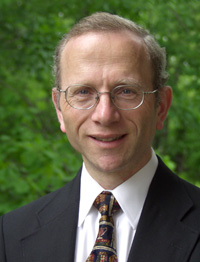By Joel Magalnick, Editor, JTNews
Religion in America runs in cycles. Sometimes it ebbs, sometimes it flows. Currently, says Prof. Jonathan Sarna of Brandeis University, this country is experiencing a religious recession, and the Jewish community is not exempt.
“The number of Americans who claim that their religion is ‘none’ has certainly grown,” said Sarna, the Joseph H. and Belle R. Braun Professor of American Jewish History and this year’s lecturer for the Samuel and Althea Stroum Lectures in Jewish Studies at the University of Washington, Revivals and Awakenings in American Judaism. “In the past, every religious decline has been followed by a religious revival. Whether that will happen now, I don’t know.”
Sarna thinks of the period between the first two world wars as one that best compares to today. Just like now, with easy distractions like Facebook and the iPhone, technology back then kept parishioners out of the pews.
“The automobile, for example, gave [people] something else to do on Sunday morning and it took a while for religion to figure out how to restructure so you make peace with this new piece of technology,” he said. “All of that is a challenge to synagogues and churches, and it will take some time before we see how that all plays out.”
The economy in this most recent decline certainly played a role, Sarna said, but something else is at play.
“Clearly when the economy collapsed, ‘The first thing I can save money on is synagogue membership,’” Sarna said, explaining many people’s rationale. “But we haven’t seen the kind of recovery in the religious realm that we have seen in the economic realm.”
Rabbi Beth Singer of Temple Beth Am, who studied under Sarna, agreed there may be a decline in religious belief.
“Most people that I know don’t want to come and sit in services on a regular basis, they don’t want to describe themselves as religious, they are really uncertain about their feelings about God,” she said.
However, her experience in Seattle differs from what she and Sarna have both seen in other communities.
“We are experiencing this tremendous influx in everything that we do at Temple Beth Am,” Singer said.
And while she sees her congregants distracted by online social media, she said, “we’re seeing that that is not enough, and there is a place for a real face-to-face, human-connection, meeting place.”
Still, denominational organizations fear for their futures. The Reform movement is struggling with how it can increase its reach and relevance for 21st-century families. The Conservative movement earlier this year approved the implementation of a strategic plan that will overhaul the way it provides services for its adherents. And in February, the Reconstructionist movement combined its organizational arm and rabbinical school, which Sarna called an admission of its significant challenges.
Sarna does not have a lot of data on the Orthodox community because so many institutions serve that population. He noted that while Orthodox Jews have many more children than the non-Orthodox, which has provided growth, not all of these children stay within the fold. In addition, the ba’al teshuvah movement that began in the 1970s, which saw many people convert to Orthodoxy, has markedly slowed.
“If you talk to rabbis, they don’t see that much of it, and synagogues are no longer filled with religious newcomers who are eager to participate,” Sarna said.
The rise of independent minyanim and similar such organizations — he cited Seattle’s Kavana Cooperative as one example of popular alternatives to a traditional shul — that began growing before the recession have also seen a slowdown, if not an outright stalling out.
The near future, at least for American Jews, will see much more interest in non-religious ways for people to express their Judaism, Sarna believes. If there has been a true rise in Jewish organizational involvement, it has been through organizations like American Jewish Word Service, which aims to strengthen Jewish identity through a social justice lens.
“We’ve seen this great movement back to social justice activities across the Jewish spectrum, including the Orthodox,” he said.
But, just as the anti-religious ideologies of Marxism and socialism “seemed to be capturing the hearts and minds of a lot of young people” in the 1920s, Sarna said, and signaled the death of religion, hardly a decade later, as Hitler began his march across Europe, a full-blown interest and revival of Judaism emerged, followed in the ‘50s by unprecedented synagogue membership.
Something equally as disastrous — or a real Mideast peace treaty — could have just as dramatic an impact, but, Sarna cautioned, “it’s hard to imagine that we can really predict what will happen.”
The Stroum Jewish Studies Program organized several community events during Sarna’s visit in part because he considers himself a perpetual student of local Jewish communities.
“I’ve found it valuable in terms of being able to talk about the American Jewish community and not falling into the trap of imagining that my Jewish community reflects the American Jewish community as a whole,” he said.
